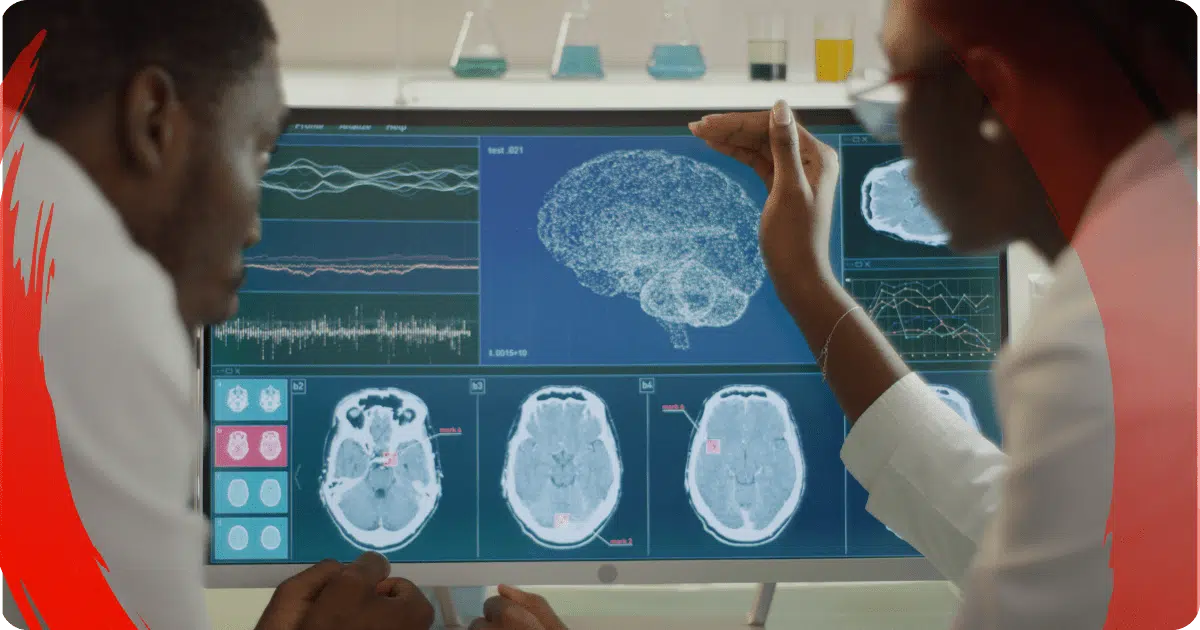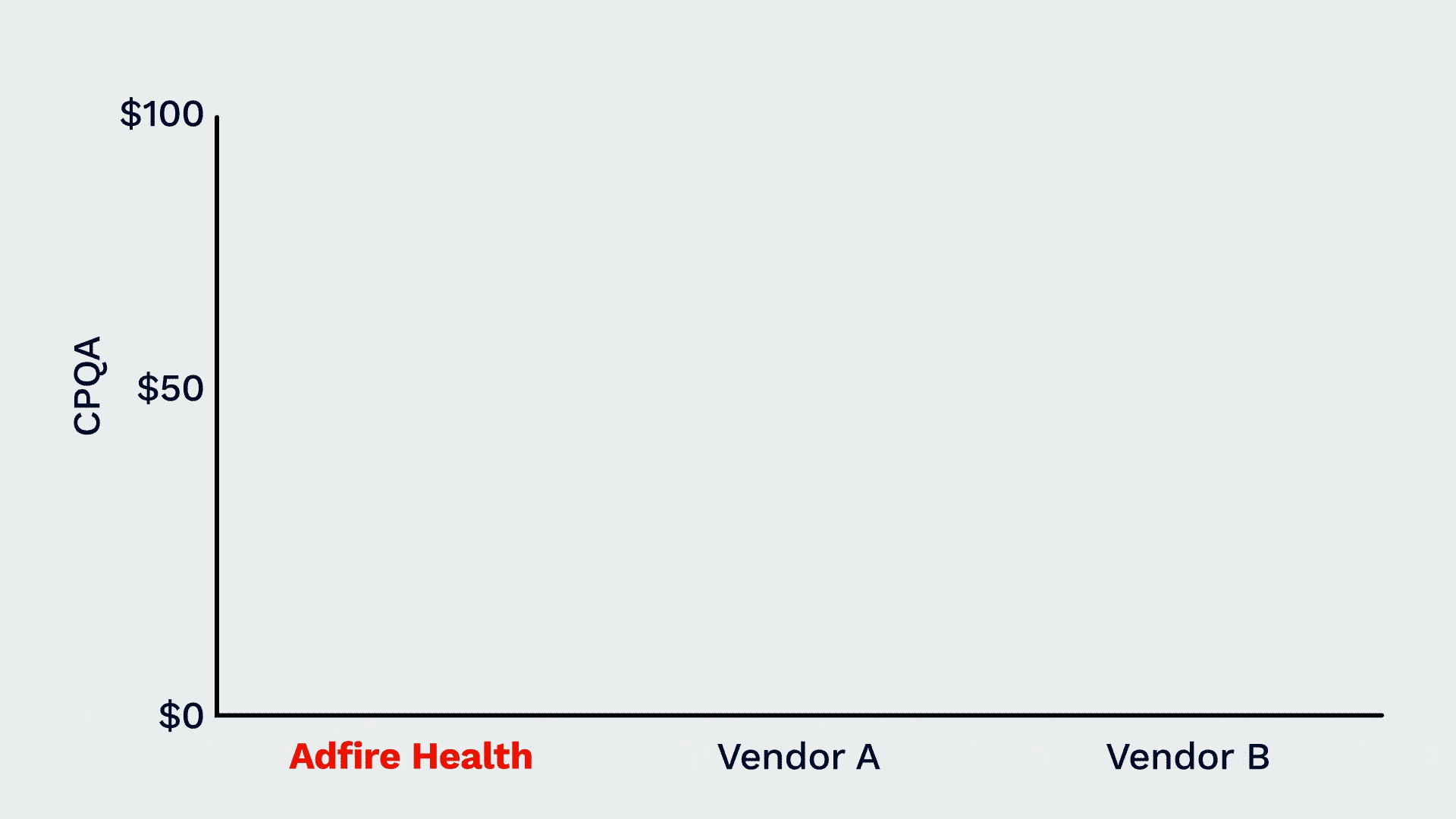A Successful Neurology Advertising Strategy
Adfire Health’s Delivers a CPQA 70% Lower Than Other Vendors

Neurological Disorder Drugs Market is Highly Competitive
A pharmaceutical brand was looking for a neurology advertising partner to inform neurologists about the efficacy of their drug treating chronic neurological sleeping disorders. Addressing the challenges of reaching, engaging, and converting neurologists posed significant hurdles.
Neurologists, deeply committed to patient care, face demanding hours and emotionally taxing work, making it hard to connect with them. The chronic shortage of neurologists in the US, where over 200 million patients (and counting)¹ compete for attention from approximately 3,500 employed neurologists,² makes their time increasingly valuable.
In addition to devoting time to patients, Neurologists must continuously navigate the influx of new drugs to provide better patient care. In 2022 alone, 22 new drugs were introduced³, with hundreds more in the neurological disorders pipeline⁴, adding to the complexity of their demanding responsibilities.
Not among the major pharmaceutical brands with extensive marketing budgets, this pharmaceutical company had to devise strategies to thrive in a highly competitive market. The company wanted to reduce the cost per qualified action (CPQA) to fill out forms on its website while increasing reach. They turned to Adfire Health to help them reach and engage with their audience.
Advertising to Neurologists
Knowing that advertising to neurologists was essential to influence prescribing behaviors and reach patients, Adfire Health created a strategy to expand reach, engagement, and conversions.
Handcrafting HCP Audience
Delivering hyper-targeted marketing campaigns to HCP audiences segmented by license type, specialty, prescribing behavior, demographics, location, and deliver more efficient results. With its proprietary database, Thumbprint, and programmatic technology, Adfire Health directly targeted neurologists. Adfire Health was able to bid on media inventory that would generate quality Neurologist impressions and give exposure to this pharma brand’s campaign.
Launching a Campaign with a Data-Focused Strategy
Adfire Health used a data-focused HCP marketing strategy, creating set measurable goals at the onset of a campaign and emphasizing analytics to drive advertising decisions. Adfire Health created two campaigns to measure reach (number of impressions) and performance (optimizing click-through rate) to achieve this client’s goals of breaking through to neurologists and improving their CPQA.
Bidding on Preferred Channels
With over 14.3 billion HCP digital transactions across campaigns, Adfire Health understands HCPs’ digital footprints and that they like to spend more time on digital devices using their accounts and emails. Like other consumers, their time is occupied with staying up to date on the news, playing games, following sports, shopping, finding recipes, streaming content, and pursuing content for their other hobbies and interests. With this knowledge, Adfire Health could start the campaign on preferred channels.
Improving Performance by Ad Type
Different ad sizes can have varying levels of effectiveness in reaching healthcare professionals, grabbing their attention, and ultimately getting them to convert. By analyzing past campaigns and learning which ad sizes resonate with healthcare professionals, Adfire Health could bid more on ad sizes and formats, delivering high impressions, click-through rates, and conversions.
Optimizing Cross-Device & In-app Targeting On Different Browsers
Adfire Health collected, analyzed, and interpreted data from various sources to gain insights into targeted neurologists’ behavior, preferences, and market trends. Adfire Health capitalized on in-app placements to extend reach by aligning ad placements with neurologists’ preferences and habits. Personalized advertising experiences were consistently sent to targeted HCP audiences across multiple devices, including desktops, smartphones, and tablets, enhancing engagement and conversion opportunities. Optimizations were made by devices, platforms, browsers, and performance metrics to improve overall campaign effectiveness.
Maximizing Retargeting Efforts
By extending the advertising lifespan beyond the initial interaction, retargeting increased the likelihood of prompting neurologists to take the desired action, whether exploring more information, engaging with the content, or completing a form fill. As a result, the campaign persistently reached highly engaged and receptive neurologists across various online platforms, maintaining a presence wherever they navigate the internet.
Increasing Efficiency with Superior Reach and Engagement

By strategically reaching neurologists and implementing tailored solutions, Adfire Health met and exceeded client expectations, earning recognition as the top partner in a third-party study conducted by IQVIA. This study revealed that Adfire Health reached more targets at a lower CPQA than two other programmatic vendors, solidifying Adfire Health as a leader in neurological disorder drug promotion.
Quality Audience Reached Provides Enhanced Cost Efficiency
Adfire Health’s campaign achieved a more favorable CPQA at $32, compared to $60 and $100 from other vendors. While other programmatic initiatives targeting a comparable audience reported higher impressions, they fell short in delivering quality reach indicated by higher CPQAs.
215K Patients Reached
Adfire Health established connections with neurologists with a reputation for serving a high-caliber patient population. The campaign reached an impressive 215,000 patients, calculated by analyzing the numbers of neurologists reached and comparing it to claims data showing prescribing behaviors.
Passing Savings To Client
Adfire Health created monthly savings reports to provide a transparent analysis of the value brought to this client’s operations. With efficiency as the primary goal, the report showed the progress made, highlighting the added value against their investment.
At Adfire Health, we work with healthcare marketers to create optimized, highly effective, data-based digital engagement strategies. With Thumbprint™, our segmented data ecosystem of over 8.2 million healthcare professionals, we can offer direct access to healthcare professionals nationwide.
We bring our years of hands-on experience to every new campaign and work with you to get the best results possible. Contact us to learn more about what we can do for your business.
Sources:
- Feigin, V., Vos, T., Alahdab, F., Amit, A. M. L., Bärnighausen, T., Beghi, E., Beheshti, M., Chavan, P., Criqui, M. H., Desai, R., Dharmaratne, S. D., Dorsey, E. R., Eagan, A. W., Elgendy, I. Y., Filip, I., Giampaoli, S., Giussani, G., Hafezi-Nejad, N., Hole, M. K., . . . Murray, C. J. L. (2021). Burden of neurological disorders across the US from 1990-2017. JAMA Neurology, 78(2), 165.
https://doi.org/10.1001/jamaneurol.2020.4152 - Neurologist Trends. (2020b, December 12).
https://www.zippia.com/neurologist-jobs/trends/ - Bryn Mawr Communications. (n.d.). Special Report: 2022 Neurology Drug & Device Approvals – Practical Neurology. Practical Neurology. https://practicalneurology.com/articles/2023-jan-feb/special-report-2022-neurology-drug-device-approvals
- Craven, Rebecca. The Lancet Neurology. The risky business of drug development in neurology. (2011, February) https://www.thelancet.com/journals/laneur/article/PIIS1474-4422(11)70004-7/fulltext